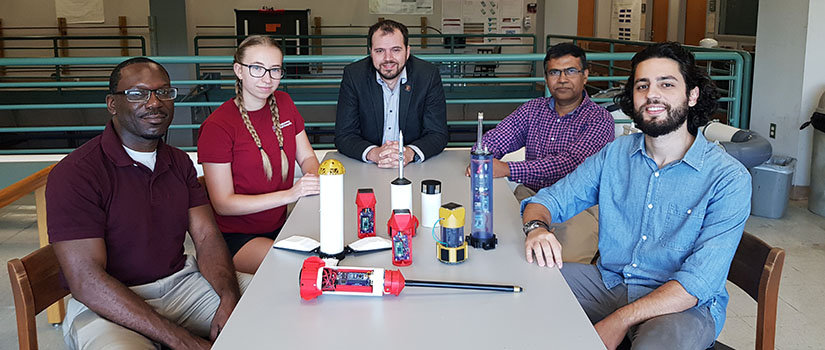In 2005, levee breaches from Hurricane Katrina left 80% of New Orleans underwater. In the United States, more than 100,000 miles of levees were built with varying levels of quality using a variety of materials that are often dictated by availability rather than engineering specifications. These aging levees are also exposed to increasing stress due to climate change.
Civil and Environment Engineering Professor Jasim Imran recently began research that aims to develop a framework, which includes smart sensors and advanced models, to better discover levee risk factors and predict where failures may occur.
Imran’s five-year, $2 million National Science Foundation-sponsored research will focus on building a data-driven fragility framework for risk assessment of levee breach. Austin Downey (mechanical engineering), Laura Micheli and Hanif Chaudhry (civil and environmental engineering), Jason Bakos (computer science and engineering) and Sadik Khan, a geotechnical engineer at Jackson State (Mississippi) University, will serve as co-principal investigators.
“Flooding is a major problem and more extreme now because of climate change. People have a false sense of security in areas protected by levees. Once the levee breaches, people are not prepared and damage is more than anticipated,” Imran says.
Accurately predicting levees’ performance and hazards are essential for managing risk in flood-prone areas. But reliable assessments are difficult due to the lack of field data. Overtopping, which is when floodwaters exceed the height of the levee, and internal erosion are two of the primary causes of levee failure, Imran’s research aims to address these and other issues through modeling and smart sensing of geotechnical (soil) and hydraulic parameters.
Imran’s team will utilize smart sensors, automated data collection and physics-based models to implement an integrated levee monitoring and flood risk assessment system. These items will help develop fragility curves, which assess the vulnerability of civil engineering structures. A risk assessment tool will link the probability of levee failure and its consequences to monetary loses. The tool will assist in monitoring and repairing vulnerable levee systems to support a decision-making process aimed at developing effective risk communication and a flood management policy.
Imran’s team will work with Khan at levees in Mississippi to perform advanced simulations and fieldwork. According to the U.S. Army Corps of Engineers, Mississippi has 110 levee systems, totaling 928 miles with an average age of 62 years.
“Having a collaborator from Mississippi was essential because that's where most levees with a diversity of ownership and performance risk are located. I've been working on levees for a while and doing mostly lab experiments and computational work. But this project gives us an opportunity to work in the field,” Imran says. “I have been working with Austin [Downey], and we have a common interest in putting sensors in the field and linking them with models.”
Downey will develop a suite of low-cost, embedded sensors that will be installed onto levees to collect spatial (space) and temporal (time) data. The sensors can communicate with one another and measure conductivity and geotechnical aspects, including soil movement and temperature to inspect and find possible levee failures. Bakos will shrink the sensors and develop custom chips to make them more efficient and powerful. Once Downey receives the data and completes sampling, he will forward that information to Khan, who will determine failure mechanisms and how and why levees fail.
“Whether or not we are able to fix the levy is debatable, but you could at least move people or get an understanding of what's about to happen,” Downey says. “No one knows exactly what material makes up the levees. A levee is not like a bridge; you can’t drive heavy loads across and test it. You'd have to flood the river.”
Micheli will develop a data-driven fragility framework that leverages probabilistic methods for assessing damage in the levee. In this context, fragility refers to the vulnerability of the levee to failure under various flood stages.
“Depending on the condition, like how much water is seeping through or the type of material, different sections of the levee can experience different levels of fragility. We want to use the field data, computational model, and fragility framework to assess the risk of breaching,” Micheli says.
Imran’s team aim for the sensors and models to help provide more awareness of vulnerability for those who manage levees. The goal is to accurately predict the time when peak flood waters will pass through identified vulnerable locations and provide an early warning of impending flooding and allow time for appropriate preparations.
According to Imran, current risk assessments are only performed when necessary and have limited depth of scientific analysis. They only include limited data and previous history. But the research team has a more comprehensive approach that determines the scientific evaluation of the levee condition and its connection to flooding,
“The performance risk of a levee has a geotechnical engineering component, which is why we are collaborating with our colleague at Jackson State,” Imran says. “We want to develop models for different mechanisms of levee failure, such as breach caused by overtopping, internal erosion in the levee or slope failure. We are bringing everything together in this framework that brings multidisciplinary expertise and perspective.”
Imran is looking forward to more convergent research, which focuses on addressing complex problems in science, engineering and society. Instead of working on an issue that can be solved by one discipline, Imran’s team has the opportunity to work with multidisciplinary approaches.
“For example, Austin and Laura were originally structural engineers. Even though they are linked to civil engineering, the field is completely different. Structural engineers don't do anything with water resources, but now we are working together,” Imran says. “Geotechnical engineers take a separate path by approaching problems in a different way, but now we are working together. My goal is to bring all the expertise together, implement new applications and solve a comprehensive problem.”
